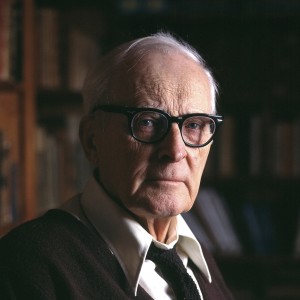Science without religion, like philosophy without religion, has nothing to feed on. . . . It is my contention that any branch of human thought without religion soon withers and dies of anemia. (“Science Fiction and the Gospel,” The Collected Works of Hugh Nibley 12:519)
The worst sinners, according to Jesus, are not the harlots and publicans, but the religious leaders with their insistence on proper dress and grooming, their careful observance of all the rules, their precious concern for status symbols, their strict legality, their pious patriotism. (“What Is Zion?,” The Collected Works of Hugh Nibley 9:54)
Religion becomes magic when the power by which things operate is transferred from God to the things themselves. . . . When men lack revelation they commonly come to think of power residing in things. . . .
In time the Bible became a magic book in men’s eyes, conveying all knowledge by its own power, without the aid of revelation. So also after a fierce controversy on the matter, priesthood itself acquired the status of a thing that automatically bestows power and grace, regardless of the spiritual or moral qualification of its possessor — it became a magic thing. (“Some Fairly Foolproof Tests,” The Collected Works of Hugh Nibley 7:261)
Humanism is very ancient. It turns up regularly as an Ersatz for religion when religion goes sour. The settled tradition is that while humanism and science represent straight and honest thinking religion is a primitive, prerational, emotional, wishful type of thinking, essentially superstitious, that humanism and science represent bold new thought while religion represents traditional, hide-bound uncritical thinking. What this view overlooks is the fact that the bold original thinking of today inevitably becomes the hide-bound authoritarian tradition of tomorrow. So that the theory itself, the belief that we have a body of study that is fresh and forward looking and that we can easily spot it and give allegiance to it, is itself a hoary superstition. (“Humanism and the Gospel,” 1)
So universally is religious ritual today burdened with the defects of oddness, incongruity, quaintness, . . . mere traditionalism, obvious faking and filling in, contrived and artificial explanations including myths and allegories, frankly sensual appeal, and general haziness and confusion, that those regrettable traits have come to be regarded as the very essence of ritual itself.
In contrast we find the Latter-day Saint rites, though full, elaborate, and detailed, to be always lucid and meaningful, forming an organic whole that contains nothing incongruous, redundant, or mystifying, nothing purely ornamental, arbitrary, abtruse, or nearly picturesque. (“What is a Temple?,” The Collected Works of Hugh Nibley 4:369)


Rick-
I’m a designer at Deseret Book working on a compilation book of Hugh Nibley’s quotes. I’m wondering if you have access to the high-resolution photo of him at the top of this post, and if you know who I could contact for rights to possibly use the photo on the cover of the book. Thanks!
Heather
I don’t recall where I obtained the photo. A web search does not seem to locate it either.
My name is Mary Jane Woodger and I am a professor at BYU. Susan Black, Lloyd Newell, and myself have written a book we are having published by Covenant Communications entitled Men of Character. We found a photos of Hugh Nibley on your site. We are hoping to get permission to publish that photos in our book. How do we go about securing permission?
As you can see in the comments, Deseret Book had a similar inquiry. I don’t recall where I got the photograph. A search of the Internet reveals copies of the photograph but at a lower resolution than the one on my blog, which would probably not suit your purposes. Sorry I am not able to help.
I was able to find the location of the original photo after a goose-hunt. It was taken by Mark Philbrick at BYU. He can be contacted at photo@byu.edu